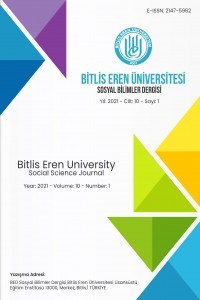Latin Amerika Vergi Sistemi Deneyimi Olarak Bolivya Vergi Sistemi
Vergi, , Vergi Sistemi, Latin Amerika, , Bolivya
___
- Anderson S. T. (2013), The Mineral Industry of Bolivia, 2011 Minerals Yearbook, U.S. Geological Survey, U.S. Department of Interior, May 2013, http://minerals.usgs.gov/minerals/pubs/country/2011/myb3-2011-bl.pdf (08.10.2018)
- Cerutti E., Jaramillo, Mansilla M., & Simone A. (2007). Bolivia:Selected Issues, International Monetary Fund Country Report, No.07/249, July.
- Coelho H. Ebrill, L. P., & Summers V. P. (2001). Bank Debit Taxes in Latin America - An Analysis of Recent Trends, IMF Working Paper, No. 01/67 (Washington: International Monetary Fund).
- Country Profile: Bolivia (2006).Library of Congress- Federal Research Division, January 2006, http://lcweb2.loc.gov/frd/cs/profiles/Bolivia.pdf (10.11.2018)
- Deloitte, Bolivia Highlights (2012). http://www2.deloitte.com/content/dam/Deloitte. /global/Docume. nts/Tax/dttl-tax-boliviahighlights-2013.pdf (27.11.2018)
- Donaldson C. V. (2007). Analysis of the Hydrocarbon Sector in Bolivia: How are the Gas and Oil Revenues Distributed”, Institute for Advanced Development Studies, Development Research Working Paper Series, No:6.
- Ernst&Young (2012), Worldwide Personal Tax Guide: Income Tax, Social Security and Immigration 2012-2013,ss.149-155.
- Faguet, J. P. (2003). Decentralization and Local Government in Bolivia: An Overview from the Bottom Up, Crisis States, Development Research Center, April. Federation of Municipal Association of Bolivia, Municipal Green Fund, http://www.fcm.ca/Documents/presentations/2010/SCC2010/Federation_of_Municipal_Associations_of_Bolivia_EN.pdf (09.11.2018)
- Inter-American Center of Tax Administrations, Bolivia, http://www.ciat.org/ind. ex.php/en/products-and-services/ciatdata/countries/bolivia.html (13.11.2018)
- Jenkins G. P., & Larrain, L. (1991). A Review of Tax Policies and Administration in Bolivia, Development Discussion Papers. 1991/10. JDI Executive Programs Legal System of Bolivia, http://www.oas.org/juridico/mla/en/bol/en_bol-int-description.pdf (09.11.2018)
- Lustig, N., Pessino, C., & Scott, J. (2013). The impact of taxes and social spending on inequality and poverty in Argentina, Bolivia, Brazil, Mexico, Peru and Uruguay: An overview. Commitment to Equity, Working Paper, No:13, April.
- Muriel B.H. (2011). Bolivian Sub-National Revenues: A Review, Institute For Advanced Development Studies, Development Research Working Paper Series, April, 2011.
- Rojas C. & Rojas, F. (2001). Guide To Doing Business in Bolivia, Lex Mundi, May, 2001.
- Sachs J. (2001). The Bolivian Hyperinflation and Stabilization, AEA papers and Proceedings, ss.278-283.
- Seemann, M. (2004). The Bolivian Decentralization Process and the Role of Municipal Associations, Hamburg Institute for International Economics, Discussion Paper, No.271, 2004.
- Türkiye Büyük Millet Meclisi Yeni Anayasa İnternet Sitesi, Bolivya Anayasası, https://yenianayasa.tbmm.gov.tr/docs/bolivya.pdf (10.11.2018)
- United Nations (2007). Republic of Bolivia, Public Administration Country Profile, Department of Economic and Social Affairs (DESA, September 2007, http://unpan1.un.org/intradoc/groups/public/documents/un/unpan028166.pdf (03.12.2018)
- http://data.worldbank.org/
- http://stats.oecd.org/
- http://www.imf.org/external/data.htm
- ISSN: 2147-5962
- Yayın Aralığı: Yılda 2 Sayı
- Başlangıç: 2012
- Yayıncı: Bitlis Eren Üniversitesi
Tedarik Zinciri Yönetimindeki Risk Faktörlerinin AHP ile Ölçülmesi: Erzurum İli Örneği
Latin Amerika Vergi Sistemi Deneyimi Olarak Bolivya Vergi Sistemi
Küreselleşme Sürecinde Talep Edilen Emeğin Niteliğindeki Değişme
Ya Brexit Sonrası? Birleşik Krallık’ın AB’den Kopuş Dönemeci ve Alternatifleri
İslam Uygarlığı’nda Kent ve Kentleşme
Ziya Gökalp’in Yeni Hayat “Mukaddimesi”ni “Şiir” ve “Şuur” Kavramları Etrafında Yeniden Okumak
1914 Tarihli Bitlis İsyanının Osmanlı Arşiv Belgelerindeki Yansımaları-Cezalar, Mükâfatlar
Yatırım Teşvikleri Nedir? Kavram ve Kapsamı Üzerine Bir Değerlendirme
Üçüncü Kişi Etkisi Teorisi Bağlamında “Ahşap Gibisi Var mı ?” Söyleminin Değerlendirilmesi
Japonya, Kore ve Vietnam'da Çin Bürokrasi Sınavları: Bölgesel Politika Yayılması Örneği
